#MoveTheDate
2.4
Days
As the world has urbanized, massive amounts of concrete are being used to literally build its foundations. If already-existing resource-efficient concrete replaced the use of conventional concrete, we could immediately move Earth Overshoot Day by 2.4 days.
What is the solution?
Developing and using alternatives to conventional concrete in order to reduce the ecological footprint associated with construction and building materials. Concrete made from secondary materials is resource-efficient and contributes to reducing the world’s largest waste stream.
This solution improves our resource security in the cities and energy categories.
How does it #MoveTheDate?
Instead of virgin material, recycled building materials are used as aggregate for the concrete production. This reduces the carbon footprint and avoids disturbing ecosystems by not mining fresh gravel and sand. If all the concrete in the world was replaced with this low-carbon, circular alternative, we could reduce the carbon footprint of concrete use by 20%, moving Earth Overshoot Day by 2.4 days. Additionally 6 billion tons of gravel and sand could be saved. This equals a fully loaded freight train with a length that would reach 32 times around the globe.
How is it scalable?
Approximately 6 billion tons of waste from buildings are produced each year, much of which could be recycled and repurposed as concrete aggregate, thereby replacing virgin aggregate in concrete. As concrete is one of the most used construction materials with a demand of 30 billion tons per year alternative concretes could make a big impact on minimizing this waste stream. Also recycling construction materials cuts down the distance that materials need to be transported and reduces the amount of raw primary material that must be extracted from the land.
What is the solution?
Developing and using alternatives to conventional concrete in order to reduce the ecological footprint associated with construction and building materials. Concrete made from secondary materials is resource-efficient and contributes to reducing the world’s largest waste stream.
This solution improves our resource security in the cities and energy categories.
How does it #MoveTheDate?
Instead of virgin material, recycled building materials are used as aggregate for the concrete production. This reduces the carbon footprint and avoids disturbing ecosystems by not mining fresh gravel and sand. If all the concrete in the world was replaced with this low-carbon, circular alternative, we could reduce the carbon footprint of concrete use by 20%, moving Earth Overshoot Day by 2.4 days. Additionally 6 billion tons of gravel and sand could be saved. This equals a fully loaded freight train with a length that would reach 32 times around the globe.
How is it scalable?
Approximately 6 billion tons of waste from buildings are produced each year, much of which could be recycled and repurposed as concrete aggregate, thereby replacing virgin aggregate in concrete. As concrete is one of the most used construction materials with a demand of 30 billion tons per year alternative concretes could make a big impact on minimizing this waste stream. Also recycling construction materials cuts down the distance that materials need to be transported and reduces the amount of raw primary material that must be extracted from the land.


Measured in weight, concrete is the most widely used construction material in the world, and has become central to our urban civilization. It is the foundation of our cities, housing, and infrastructure. Approximately 30 billion tons of concrete are poured every year, and the demand is only expected to increase as populations continue to expand and urbanize. The demolition waste from buildings is also rising and is one of the biggest waste streams worldwide. The production of cement, a key component of concrete, involves combustion processes that release CO2 into the atmosphere, contributing to global climate change. Each year, approximately 3 billion tons of CO2 can be traced back to cement production, representing 8% of global carbon emissions. Therefore, there is an urgent need to develop more sustainable alternatives.
A number of companies are doing just that, leading the charge to transform the environmental impact of the industry. The Swiss construction company Eberhard has introduced zirkulit®, a low-carbon, circular concrete that is largely composed of recycled materials. The aggregate material in zirkulit® concrete is made up of around 85% recycled, secondary material, massively reducing the need to mine primary material from gravel quarries. The use of recycled building material also reduces the waste stream. In this way zirkulit® contributes to the circular economy as it closes material cycles. Recycling also cuts down the transport distance of heavy materials and helps maintain the integrity of natural ecosystems. Additionally, zirkulit® concrete is optimized to use almost 7% less cement than conventional concrete, and one that is more carbon efficient in its production. Yet, this new concrete provides the same mechanical and chemical qualities as conventional concrete. The zirkulit® concrete also uses carbon sequestration capabilities of the aggregate itself, further lowering the CO2 impact.
Developing new and innovative alternatives to traditional building materials and construction approaches reduces the Ecological Footprint of buildings and the construction sector. Improving the ecological performance of concrete is a key contribution to humanity’s ability to Move the Date. Our calculations with engineers from Eberhard have concluded that these technologies, if applied to replace conventional concrete, have the potential to reduce the carbon Footprint of concrete by at least 20%.
There’s no benefit in waiting!
Acting now puts you at a strategic advantage in a world increasingly defined by ecological overshoot. Countless solutions exist that #MoveTheDate. They’re creative, economically viable, and ready to deploy at scale. With them, we can make ourselves more resilient and #MoveTheDate of Earth Overshoot Day. If we move the date 6 days each year, humanity can be out of overshoot before 2050.
